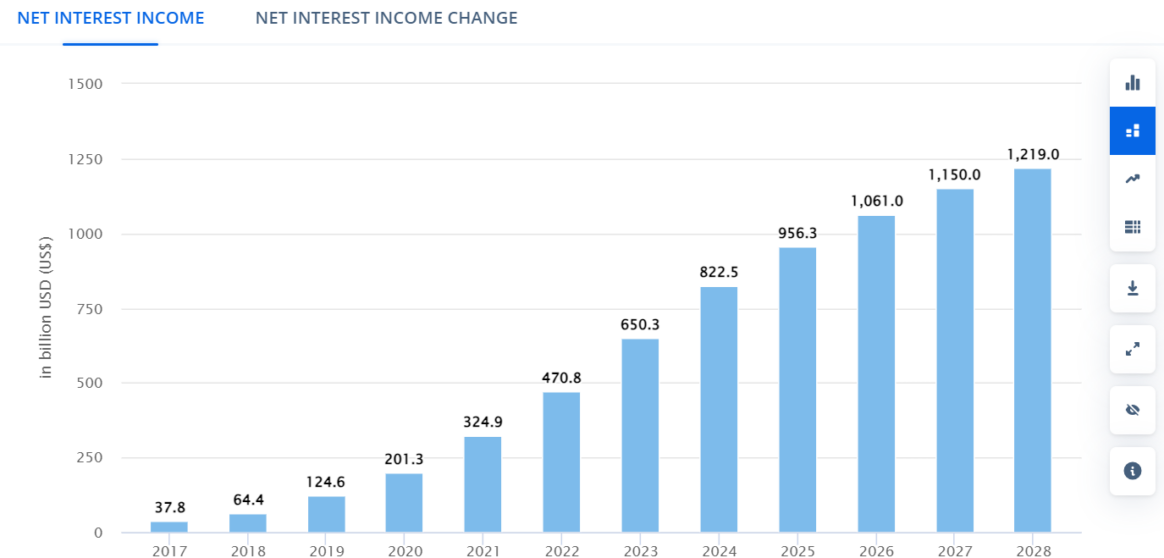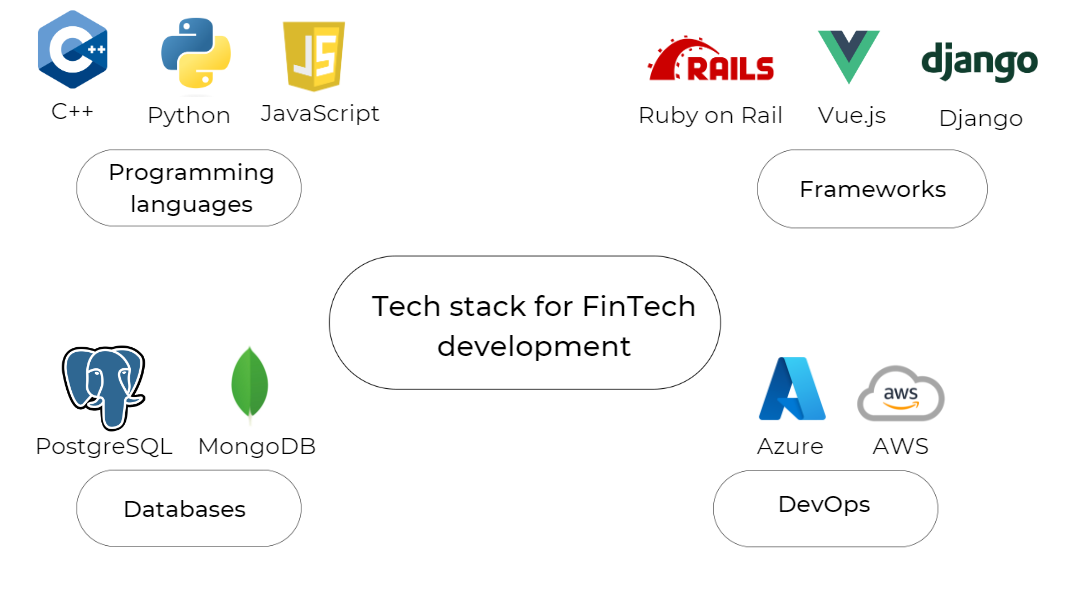According to report, the number of online banking users worldwide is expected to reach 3.6 billion by 2024. The digital transformation of banking is forcing financial institutions to meet the needs of modern customers.
With an efficient digital banking platform, your company can boost customer loyalty, increase revenue, and reduce the cost of services. Let’s take a look at the key steps to successfully developing a financial platform.
Table of contents
What is a digital banking platform?
A digital banking platform is an online system that allows customers to conduct a range of financial transactions through a website or mobile app. It typically includes features such as online account management, money transfers, bill payments, mobile banking, and other financial activities.
Digital banking platforms aim to provide a seamless and user-friendly experience that allows customers to carry out banking transactions from the convenience of their computers or mobile devices.
According to Statista research, digital banking income is expected to show an annual growth rate (CAGR 2023-2028) of 13.39%, resulting in a market volume of US$1,219bn by 2028.
Digital banking worldwide income

Source: Statista Market Insights
The popularity of digital technologies and consumer preferences — particularly among millennials and Generation Z, who are likely to conduct financial transactions through digital channels — are two key factors driving the digital banking market.
By offering convenient online banking services that meet the needs of modern customers, financial companies can increase revenues from this trend.
Scalable FinTech Platform
Develop your payment product faster, using the SDK.finance software
Must-have features of digital banking platform
The fintech sector is one of the industries most strongly influenced by the digital trends of recent years.
These trends enable payment service providers to improve the quality of services for their customers but also pose a certain challenge for the Fintech software development and improvement of products.
The following highlights the most important features to focus on when developing a banking platform:
- Account management
- Fund transfers
- Bill payments
- Mobile banking
- Card management
- Advanced security features
- Integration options
- Customer support
When we think about what features a digital banking solution must have, it becomes clear that the focus on customer needs is paramount. That’s why you should differentiate your banking solution from others by using a customer-centric development approach.
In the following sections, we will analyze the 8 key steps in successfully developing a digital banking platform that meets both user and business needs.
Step 1. Define clear objectives and requirements
The most important thing in setting clear goals and requirements is to conduct market and consumer research to determine the needs, preferences, behaviors, and motivations of your potential customers.
This step will help you maximize the revenue of your future solution and save time and effort by understanding the requirements of a particular product and its value to users.
Dedicated FinTech development team
Bring your financial product vision to life with SDK.finance team
You can also make estimates based on the documented requirements and determine the schedule and cost plan for the project.
Step 2. Choose the right technology stack
The requirements for a FinTech product can have a significant impact on the technology chosen for its development.
Digital banking software involves handling sensitive financial data, and stringent security measures leading to the implementation of robust encryption protocols, secure APIs, and multi-factor authentication, which impacts the choice of specific technology.
Choosing a technology stack for digital banking software depends on project requirements, scalability, security, and regulatory compliance. Below you will find a general overview of a commonly used technology stack in fintech development:

Read our article on best tech stack for financial development to get more information about these technologies.
Step 3. Differentiate with a customer-oriented approach
A good customer-centric approach is not just about the aesthetics of the platform, but more about its usability, accessibility and intuitive design.
The result is software that promotes customer satisfaction and loyalty. Key principles of customer-centric software development are as follows:
- Flexibility: the digital banking platform adapts to changing customer behavior and needs.
- Scalability: the system provides continuous updates and incremental changes.
- Engagement: banking software incorporates the expertise of the customer base at multiple levels.
As an example, Amazon, the global retail brand, is one of them and stands as the highest-rated customer-centric company in the world.
The company carefully analyzes customer data and uses a diagnostic approach to understand each user’s interactions with the platform to offer personalized recommendations based on browsing and purchasing behavior.
Step 4. Ensure security
When developing FinTech products, security is paramount, especially when it comes to sensitive financial data.
You need to implement advanced encryption protocols such as SSL/TLS to ensure secure communication between users and the banking platform. It is also important to regularly update and monitor the APIs used for integration to mitigate potential vulnerabilities.
Affordable SaaS Software
Develop your own neobank faster with SDK.finance FinTech Platform
Conduct regular security audits and penetration tests to identify and fix vulnerabilities. Regular assessments help to stay one step ahead of potential threats and ensure continuous security.
Read our article on what is digital banking to explore its meaning, types and key benefits for financial businesses.
Step 5. Regulatory compliance
While digital banks strive to be innovative and do unconventional things, they still have to comply with the same regulations as traditional banks. Compliance with regulatory laws makes the industry less susceptible to attacks and vulnerabilities.
There are three main risks for financial institutions:
- Data privacy.
In countries that belong to the European Union, non-compliance with data leakage regulations can lead to a fine of 2-4% of a company’s turnover.
2. Money laundering
Companies and governmental organizations lose more than $2 trillion annually as a result of money laundering.
3. Cybertattacs
To protect users from potential attacks and data breaches, financial companies must comply with the following regulations:
- PCI DSS (Payment Card Industry Data Security Standard) outlines security requirements for companies that handle credit card data.
- PSD2 (Second Payment Services Directive) is an EU regulation for electronic payment services.
- GDPR (General Data Protection Regulation) regulates the collection, use, and storage of personal data for companies operating in the European Union.
- The AML (Anti-Money Laundering) regulations serve to prevent and combat money laundering activities and the financing of terrorism.
- KYC procedures are a subset of AML regulations that require institutions to verify the identity of their customers.
Regulatory landscapes can vary significantly from country to country and compliance with local laws is critical for successful digital banking platform launch.
In this article you can find more information about the payment regulatory landscape.
Step 6. Develop the platform
Software development is the most important step in setting up a digital bank, as it serves as the foundation on which the entire digital banking infrastructure rests. It is a process of frontend, backend development, and data integration.
In this step, the actual architecture of your product is defined.
Therefore it is important to carry out the development process by professionals with experience in the fintech sector. You can use an internal development team or hire a software development team with in-depth technical knowledge of the financial sector.
A dedicated FinTech software development team by SDK.finance can speed up the launch of your digital banking platform, without an exhaustive hiring process.
Using the SDK.finance FinTech Platform, our experienced development teams with 10+ years of experience in the FinTech industry can implement your financial product idea fast and efficiently.
Step 7. Test and launch
Thorough testing not only helps to find and fix problems but also ensures a great user experience and increases confidence in your digital banking solution. Various test methods, including functional tests, security tests, and user acceptance tests, help to check the performance of the platform in different scenarios.
FinTech development services
Build your PayTech product faster with SDK.finance development servides
The launch is the last step of the development process, but it is not the end of your work. You should also monitor performance, usage, and feedback on your update by using tools such as analytics, surveys, or reviews. It’s also important that you can respond to any issues, complaints, or questions and provide support and guidance to your customers and users.
Step 8. Improve the application
The journey doesn’t end with the software launch; rather, it is just the beginning of a continuous process and further improvement. To ensure the long-term success of your financial platform, you should prioritize continuous improvement. Here’s how:
Create a user feedback mechanism:
- Set up clear channels for users to provide feedback.
- Actively seek out and listen to user suggestions and concerns.
Regularly update the system:
- Schedule and implement regular software updates with new features and improvements.
- Fix bugs and improve features based on user feedback.
Optimize performance:
- Continuously monitor and optimize the performance of the application.
- Identify and fix any bottlenecks that affect the user experience.
These steps will help your solution stay relevant and meet the ever-changing needs and expectations of users.
SDK.finance digital banking platform
The SDK.finance FinTech Platform serves as a scalable foundation for building digital banking products. The system is a pre-developed backend solution on which the development team can build, easily make integrations and scale up and down.
The platform covers customer, merchant, and individual functionalities, including:
- Self-registration
- KYC management
- Multi-currency accounts
- P2P transfer, payment,
- Top-up and withdrawal
- Currency exchange
- Transaction history and activity logging
- User management
- Fee and limit management
The platform’s hybrid cloud deployment facilitates regulatory compliance by storing the backend application on the major cloud providers’ servers and your database on your servers to ensure data security and compliance with data location regulations.
Wrapping up
These 8 steps pave the way for the successful introduction of a digital banking platform. By adapting to market needs, ensuring a high level of security and focusing on a customer-friendly design, financial institutions can develop a smooth and secure online banking product.
With its scalability, API-first approach, and core features, SDK.finance accelerates the development of digital banking products, without starting from scratch.
- SEO Powered Content & PR Distribution. Get Amplified Today.
- PlatoData.Network Vertical Generative Ai. Empower Yourself. Access Here.
- PlatoAiStream. Web3 Intelligence. Knowledge Amplified. Access Here.
- PlatoESG. Carbon, CleanTech, Energy, Environment, Solar, Waste Management. Access Here.
- PlatoHealth. Biotech and Clinical Trials Intelligence. Access Here.
- Source: https://sdk.finance/from-vision-to-reality-key-steps-for-a-digital-banking-platform-development/



